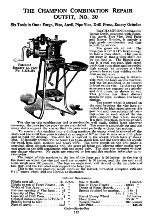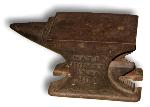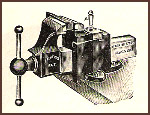Image Champion Catalog 1920
Finding one of these or others of its kind intact is unusual but finding the heaviest piece, the anvil/vise body, is more common.
The rest of the parts were often broken or lost and discarded but the anvil would be set aside and thus many survive.
When these are found they are often thought to be actual anvils, not just parts of a larger device.
This multi-tool was equiped with forge, vise, anvil, drill press, and grinding wheel.
While it was advertised as "high grade" the anvil/vise was cast iron with chilled (hardened) faces.
This was the lowest quality of anvil and vise manufacturing of the time and was generally relegated to hobby and light bench work anvils, never for forging.
Vises of the time were made from ductile iron or semi-steel.

An interesting feature of this tool was the gear box which was moved from the forge blower to the graindr and drill positions.
Full Page Detail







Image Champion Catalog 1920
Finding one of these or others of its kind intact is unusual but finding the heaviest piece, the anvil/vise body, is more common. The rest of the parts were often broken or lost and discarded but the anvil would be set aside and thus many survive. When these are found they are often thought to be actual anvils, not just parts of a larger device.
This multi-tool was equiped with forge, vise, anvil, drill press, and grinding wheel. While it was advertised as "high grade" the anvil/vise was cast iron with chilled (hardened) faces. This was the lowest quality of anvil and vise manufacturing of the time and was generally relegated to hobby and light bench work anvils, never for forging. Vises of the time were made from ductile iron or semi-steel.
An interesting feature of this tool was the gear box which was moved from the forge blower to the graindr and drill positions.
Full Page Detail